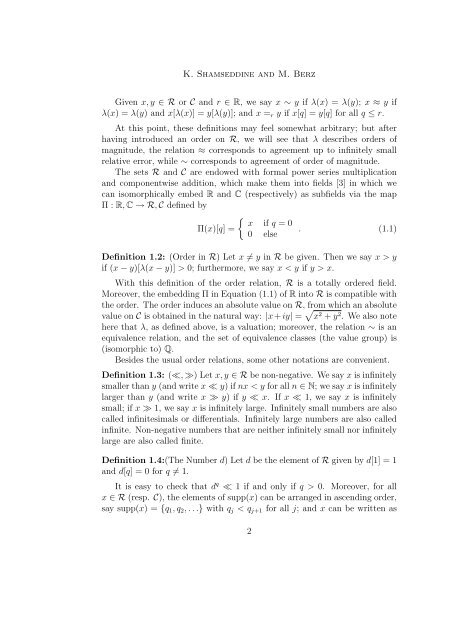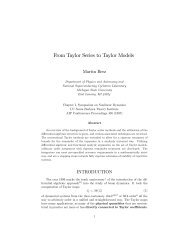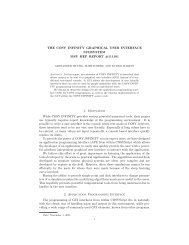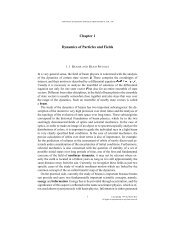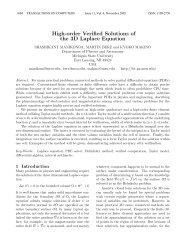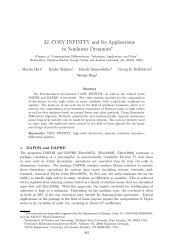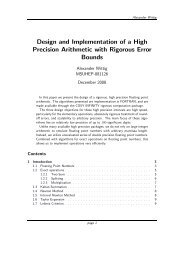Analytical Properties of Power Series on Levi-Civita Fields 1 ...
Analytical Properties of Power Series on Levi-Civita Fields 1 ...
Analytical Properties of Power Series on Levi-Civita Fields 1 ...
You also want an ePaper? Increase the reach of your titles
YUMPU automatically turns print PDFs into web optimized ePapers that Google loves.
K. Shamseddine and M. Berz<br />
Given x, y ∈ R or C and r ∈ R, we say x ∼ y if λ(x) = λ(y); x ≈ y if<br />
λ(x) = λ(y) and x[λ(x)] = y[λ(y)]; and x = r y if x[q] = y[q] for all q ≤ r.<br />
At this point, these definiti<strong>on</strong>s may feel somewhat arbitrary; but after<br />
having introduced an order <strong>on</strong> R, we will see that λ describes orders <str<strong>on</strong>g>of</str<strong>on</strong>g><br />
magnitude, the relati<strong>on</strong> ≈ corresp<strong>on</strong>ds to agreement up to infinitely small<br />
relative error, while ∼ corresp<strong>on</strong>ds to agreement <str<strong>on</strong>g>of</str<strong>on</strong>g> order <str<strong>on</strong>g>of</str<strong>on</strong>g> magnitude.<br />
The sets R and C are endowed with formal power series multiplicati<strong>on</strong><br />
and comp<strong>on</strong>entwise additi<strong>on</strong>, which make them into fields [3] in which we<br />
can isomorphically embed R and C (respectively) as subfields via the map<br />
Π : R, C → R, C defined by<br />
Π(x)[q] =<br />
{ x if q = 0<br />
0 else<br />
. (1.1)<br />
Definiti<strong>on</strong> 1.2: (Order in R) Let x ≠ y in R be given. Then we say x > y<br />
if (x − y)[λ(x − y)] > 0; furthermore, we say x < y if y > x.<br />
With this definiti<strong>on</strong> <str<strong>on</strong>g>of</str<strong>on</strong>g> the order relati<strong>on</strong>, R is a totally ordered field.<br />
Moreover, the embedding Π in Equati<strong>on</strong> (1.1) <str<strong>on</strong>g>of</str<strong>on</strong>g> R into R is compatible with<br />
the order. The order induces an absolute value <strong>on</strong> R, from which an absolute<br />
value <strong>on</strong> C is obtained in the natural way: |x + iy| = √ x 2 + y 2 . We also note<br />
here that λ, as defined above, is a valuati<strong>on</strong>; moreover, the relati<strong>on</strong> ∼ is an<br />
equivalence relati<strong>on</strong>, and the set <str<strong>on</strong>g>of</str<strong>on</strong>g> equivalence classes (the value group) is<br />
(isomorphic to) Q.<br />
Besides the usual order relati<strong>on</strong>s, some other notati<strong>on</strong>s are c<strong>on</strong>venient.<br />
Definiti<strong>on</strong> 1.3: (≪, ≫) Let x, y ∈ R be n<strong>on</strong>-negative. We say x is infinitely<br />
smaller than y (and write x ≪ y) if nx < y for all n ∈ N; we say x is infinitely<br />
larger than y (and write x ≫ y) if y ≪ x. If x ≪ 1, we say x is infinitely<br />
small; if x ≫ 1, we say x is infinitely large. Infinitely small numbers are also<br />
called infinitesimals or differentials. Infinitely large numbers are also called<br />
infinite. N<strong>on</strong>-negative numbers that are neither infinitely small nor infinitely<br />
large are also called finite.<br />
Definiti<strong>on</strong> 1.4:(The Number d) Let d be the element <str<strong>on</strong>g>of</str<strong>on</strong>g> R given by d[1] = 1<br />
and d[q] = 0 for q ≠ 1.<br />
It is easy to check that d q ≪ 1 if and <strong>on</strong>ly if q > 0. Moreover, for all<br />
x ∈ R (resp. C), the elements <str<strong>on</strong>g>of</str<strong>on</strong>g> supp(x) can be arranged in ascending order,<br />
say supp(x) = {q 1 , q 2 , . . .} with q j < q j+1 for all j; and x can be written as<br />
2


